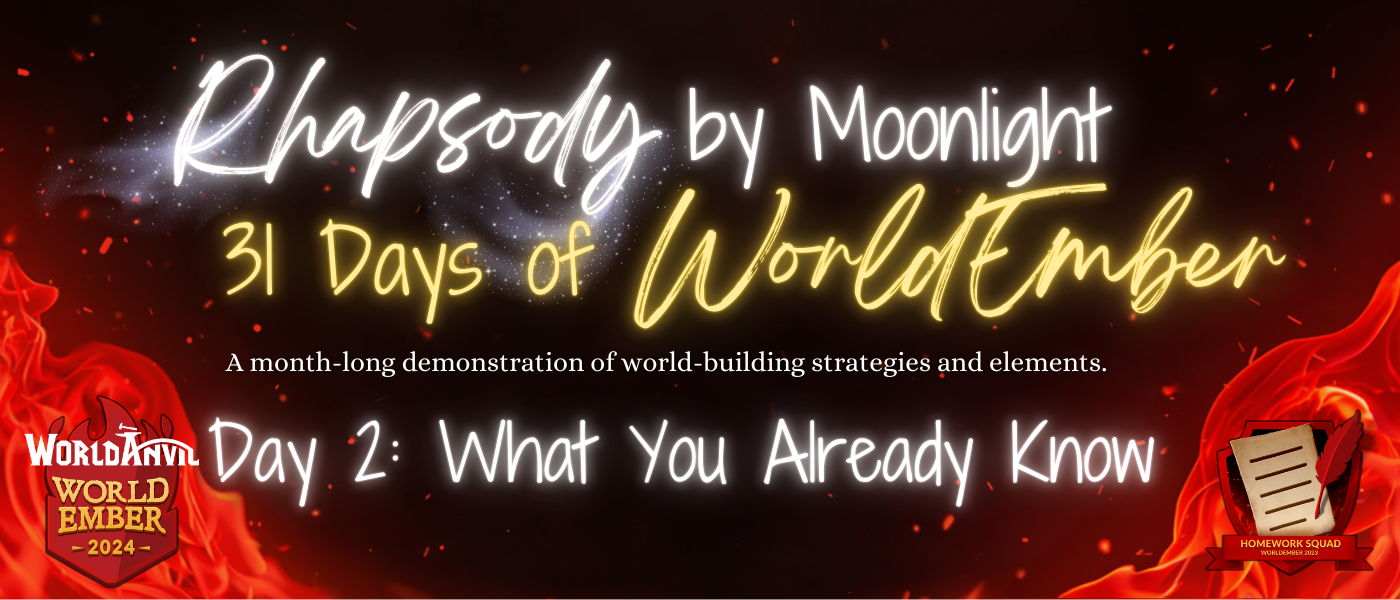Day 2: What You Already Know
Follow along with my WorldEmber progress!
I promised you a look over my shoulder this month as I bring a vague and disjointed collection of ideas together into a cohesive piece of world-building. These resources will help you keep track of my progress through this month-long marathon challenge:
- Haly’s Official WE Progress Report — each participant gets a page that automatically collects their author information and all WE-eligible articles across all worlds into a single, shareable package.
- A WorldEmber Chronicle — follow along with a map and timeline of my progress. You’ll see locations and information develop day-by-day as I work my way through the basic elements of world-building.
- Haly’s WorldEmber on Argentii Index — an on-the-fly journal page and handy sidebar displaying only new Argentii WE-eligible articles.
Ocean Method: Trying Not to Drown
Creating a believable world is a complex task. It’s easy to imagine a new world. But to actually take that unformed piece of imagination and convert it into something that can live outside of your head and inside of someone else’s…that is an entirely different skill-set.
Now that I’ve cleaned up my stubs, those tidbit ideas that should have been fleshed out long ago, it’s time to move on to some of the foundational elements of world-building. There’s no wrong place to start world-building, but the best place to start is with something familiar, something you know. That’s why we start with stubs, and why we look for keys in the world-building that we’ve already done.
Darian’s Folly
One of the foundational elements of Argentii is the division between the Eastern Union and the Western Empire, and so that’s what I wrote about tonight.
When I first started thinking about Argentii, I knew that there was a mad king who, when his wife had twins, divided the kingdom in two so that it wouldn’t be torn apart in some inheritance feud. He became so obsessed with this idea, that he wouldn’t let his poor wife rest. She bore eight living children before finally birthing the twins that fulfilled Darian’s imagined prophecy.
From there, other things sprang up, such as Division River and Crossroads Island. (Library Inn was already established, though it moved from being a simple wood and stone mansion to being the former palace inside the Old Castle that was the seat of government, and her home, until the Division.
They are not in-depth articles, I only jotted down a few key details. To be honest, world-building on a national scale like that is a challenge for me. It’s difficult to stereotype Argentii’s vast population, split almost evenly between East and West. Right now, we just need to get the gist and a couple of facts. That way, I don’t back myself into a corner later.
The most immediate information for new readers is contained there, the key cultural differences and the share economics. As I develop more details that fit within the framework established in those key items, I can add them in. For now, it’s got the ‘concepts, cogs, and tables’ necessary to spark the imagination.
Avoid the Deep Ocean
World-building with the Ocean method involves being broad with our scope, and not going too deep. Because I like to tell character-driven stories, much of my world-building revolves around individuals and their daily lives. I don’t know the details of how the governments of those nations work because they simply don’t apply to the characters I’ve been working with.
However, as I develop a story, it’s entirely probable that I’ll need to know — and therefore establish — exactly how the East’s republic government functions; same goes for the West. The world has grasped how these things operate, and can function perfectly without my input. Until, of course, I need to break it all. And as we all know, you can’t break the rules until you know what they are!
Deliberate World-building, Step-by-Step
Begin with what you know:
- Start with the things you’ve already written. Let those little stubs guide you toward a focus, look for places where they intersect, overlap, and piece together. (Dec. 2)
- Move on to the firm foundations, the things that you already know are set in stone. This might be a geographic feature, a character, a cultural touchstone (“known for their spicy food”), or any other hard, established facts about your world. (Dec. 2)
Wrapping the Day
As I write this, I am sitting at 4,529 new words of world-building toward my 50,000 word goal.








Comments